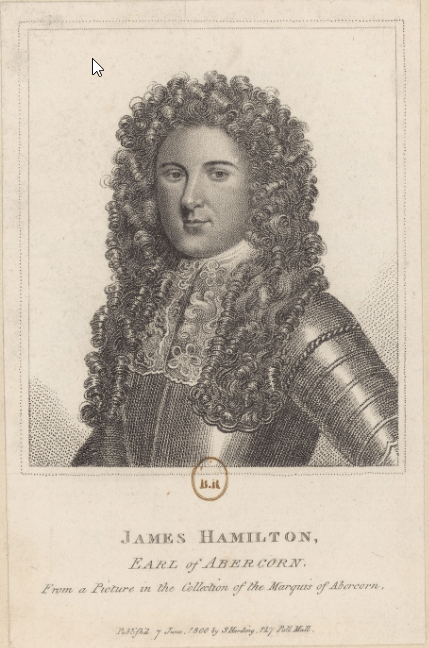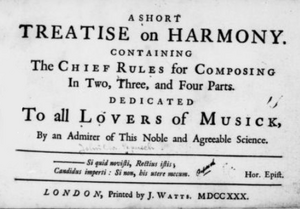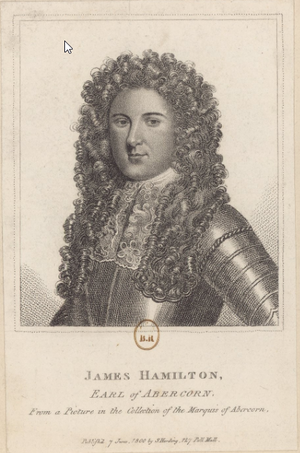James Hamilton, 7th Earl of Abercorn facts for kids
Quick facts for kids
James Hamilton
|
|
|---|---|
| Earl of Abercorn | |
|
Detail from portrait below
|
|
| Tenure | 1734–1744 |
| Predecessor | James, 6th Earl of Abercorn |
| Successor | James, 8th Earl of Abercorn |
| Born | 22 March 1686 |
| Died | 11 January 1744 (aged 57) Cavendish Square, London |
| Buried | Westminster Abbey |
| Spouse(s) | Anne Plumer |
| Issue Detail |
James, John & others |
| Father | James Hamilton |
| Mother | Elizabeth Reading |
James Hamilton, 7th Earl of Abercorn (1686–1744) was an important Scottish and Irish nobleman. He was also known as Lord Paisley from 1701 to 1734. He was very interested in science and music. He even wrote a book about magnets in 1729. He also wrote about music in 1730, which his teacher, Dr. Pepusch, later improved and re-released.
Contents
Who Was James Hamilton?
James Hamilton was born on 22 March 1686. He was the second son of James Hamilton and Elizabeth Reading. He was the oldest son who lived to adulthood. His family, the Abercorn Hamiltons, moved from Scotland to Ireland. This happened during a time called the Plantation of Ulster, when many Scottish and English people settled in Ireland.
James's mother, Elizabeth, was the only child of Sir Robert Reading. James's parents were Protestants and got married in January 1684. James had 13 brothers and sisters.
| Family tree | |||||||||||||||||||||||||||||||||||||||||||||||||||||||||||||||||||||||||||||||||||||||||||||||||||||||||||||||||||||||||||||||||||||||||||||||||||||||||||||||||||||||||||||||||||||||||||||||||||||||||||||||||||||||||||||||||||||||||||||||||||||||||||||||||||||||||||||||||||||||||||||||||||||||||||||||||||||||||||||||||||||||||||||||||||||||||||||||||||||||||||||||||||||||||||||||||||||||||||||||||||||||||||||||||||||||||||||||||||||||||||||||||||||||||||||||||||||||||||||||||||||||||||||||||||||||||||||||||||||||||||||
|---|---|---|---|---|---|---|---|---|---|---|---|---|---|---|---|---|---|---|---|---|---|---|---|---|---|---|---|---|---|---|---|---|---|---|---|---|---|---|---|---|---|---|---|---|---|---|---|---|---|---|---|---|---|---|---|---|---|---|---|---|---|---|---|---|---|---|---|---|---|---|---|---|---|---|---|---|---|---|---|---|---|---|---|---|---|---|---|---|---|---|---|---|---|---|---|---|---|---|---|---|---|---|---|---|---|---|---|---|---|---|---|---|---|---|---|---|---|---|---|---|---|---|---|---|---|---|---|---|---|---|---|---|---|---|---|---|---|---|---|---|---|---|---|---|---|---|---|---|---|---|---|---|---|---|---|---|---|---|---|---|---|---|---|---|---|---|---|---|---|---|---|---|---|---|---|---|---|---|---|---|---|---|---|---|---|---|---|---|---|---|---|---|---|---|---|---|---|---|---|---|---|---|---|---|---|---|---|---|---|---|---|---|---|---|---|---|---|---|---|---|---|---|---|---|---|---|---|---|---|---|---|---|---|---|---|---|---|---|---|---|---|---|---|---|---|---|---|---|---|---|---|---|---|---|---|---|---|---|---|---|---|---|---|---|---|---|---|---|---|---|---|---|---|---|---|---|---|---|---|---|---|---|---|---|---|---|---|---|---|---|---|---|---|---|---|---|---|---|---|---|---|---|---|---|---|---|---|---|---|---|---|---|---|---|---|---|---|---|---|---|---|---|---|---|---|---|---|---|---|---|---|---|---|---|---|---|---|---|---|---|---|---|---|---|---|---|---|---|---|---|---|---|---|---|---|---|---|---|---|---|---|---|---|---|---|---|---|---|---|---|---|---|---|---|---|---|---|---|---|---|---|---|---|---|---|---|---|---|---|---|---|---|---|---|---|---|---|---|---|---|---|---|---|---|---|---|---|---|---|---|---|---|---|---|---|---|---|---|---|---|---|---|---|---|---|---|---|---|---|---|---|---|---|---|---|---|---|---|---|---|---|---|---|---|---|---|---|---|---|---|---|---|---|---|---|---|---|---|---|---|---|---|---|---|---|---|---|---|---|---|---|---|---|---|---|---|---|---|---|---|---|---|---|---|---|---|---|---|---|---|---|---|---|---|---|---|---|---|---|---|---|---|---|---|---|---|---|---|---|---|---|---|---|---|---|---|---|---|---|---|---|---|---|---|---|
|
|||||||||||||||||||||||||||||||||||||||||||||||||||||||||||||||||||||||||||||||||||||||||||||||||||||||||||||||||||||||||||||||||||||||||||||||||||||||||||||||||||||||||||||||||||||||||||||||||||||||||||||||||||||||||||||||||||||||||||||||||||||||||||||||||||||||||||||||||||||||||||||||||||||||||||||||||||||||||||||||||||||||||||||||||||||||||||||||||||||||||||||||||||||||||||||||||||||||||||||||||||||||||||||||||||||||||||||||||||||||||||||||||||||||||||||||||||||||||||||||||||||||||||||||||||||||||||||||||||||||||||||
Becoming Lord Paisley
When James was a child, his father helped King William during a war in Ireland. His father brought supplies to the city of Derry during a difficult time called the Siege of Derry.
In 1701, a relative named Charles Hamilton, 5th Earl of Abercorn died without children. Because of this, James's father became the 6th Earl of Abercorn. James was 15 years old at the time. He then became the next in line to inherit the title, and people started calling him Lord Paisley.
Family Life
In April 1711, Lord Paisley married Anne Plumer (1690–1776). She was the daughter of Colonel John Plumer.
James and Anne had eight children, six sons and two daughters:
- James (1712–1789), who became the 8th Earl of Abercorn after his father.
- John (around 1714 – 1755), who was a Captain in the Royal Navy.
- William, who died when he was young.
- Anne (1715–1792), who married Sir Henry Mackworth, 6th Baronet.
- George (1718–1787), who became a church official called a Canon of Windsor.
- Plumer Hamilton, who also died young.
- William (1721–1744), who was lost at sea when his ship, HMS Victory, sank.
- A daughter born in 1736, who died as a baby.
His Scientific and Musical Interests
James Hamilton was very smart and curious. On 10 November 1715, he was chosen to be a Fellow of the Royal Society. This is a group of very important scientists.
He was also a Freemason, which is a member of a social and charitable organization. He was even the Grand Master of the Premier Grand Lodge of England from 1725 to 1726.
In 1729, he published a small book called Calculations and Tables Relating to the Attractive Virtue of Loadstones. In this book, he shared his experiments with lodestones. These are natural magnets. He measured how much iron different sizes of magnets could hold.
Lord Paisley also loved music. He took lessons from Johann Christoph Pepusch, a famous musician. In 1730, he wrote a book about music called "A Short Treatise on Harmony." He based it on what Pepusch taught him. His teacher was a bit upset because James published it without asking. The book wasn't very well written at first. So, Pepusch helped him create a better version, which came out in 1731. This improved book showed how the best composers of that time created music. Even after this, James and Pepusch remained friends.
Becoming the Earl of Abercorn
In 1734, James's father passed away. Lord Paisley then became the 7th Earl of Abercorn. He also became the 2nd Viscount Strabane in Ireland.
He became a Privy Counsellor in Great Britain on 20 July 1738. This meant he was a trusted advisor to the King. He was also appointed to the Privy Counsellor in Ireland in July 1737. He officially took his place there on 26 September 1739 when he visited Ireland.
On 17 October 1739, King George II gave a special permission, called a royal charter, for the first orphanage in the country. This was for children who had been left without parents. It was called the Foundling Hospital. Lord Abercorn was one of the many people who helped start and run this important place.
His Later Years and Death
Lord Abercorn died on 11 January 1744. He was 57 years old. He passed away in Cavendish Square in London. Five days later, he was buried in Westminster Abbey. This is a very famous church where many important people are buried. His father was also buried there.
| Timeline | ||
|---|---|---|
| Age | Date | Event |
| 0 | 1686, 22 Mar | Born |
| 15 | 1701, Jun | Became Lord Paisley when his father became the 6th Earl of Abercorn. |
| 25 | 1711, Apr | Married Anne Plumer. |
| 29 | 1715, 10 Nov | Chosen as a Fellow of the Royal Society. |
| 43 | 1729 | Published his book on magnets. |
| 48 | 1734, 28 Nov | Became the 7th Earl of Abercorn after his father died. |
| 52 | 1738, 20 Jul | Became a Privy Counsellor in Great Britain. |
| 53 | 1739, 26 Sep | Became a Privy Counsellor in Ireland. |
| 57 | 1744, 11 Jan | Died in London. |




